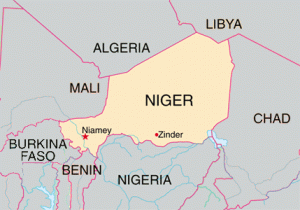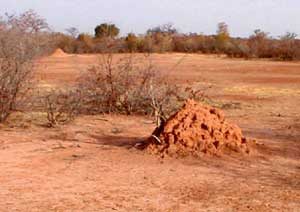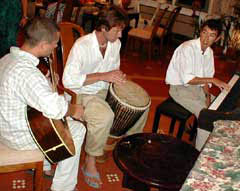 After a few weeks in sweltering Washington and other parts of the eastern US, we are enjoying the relative comfort of the southern edge of the Sahara. The rainy season has arrived, which in Niamey means only a couple of hours of hard rain per week; but it also brings some clouds to moderate the fiery temperatures of April and May. While still hot by most standards, the “heat index” here is surely lower than Washington’s in late July.
After a few weeks in sweltering Washington and other parts of the eastern US, we are enjoying the relative comfort of the southern edge of the Sahara. The rainy season has arrived, which in Niamey means only a couple of hours of hard rain per week; but it also brings some clouds to moderate the fiery temperatures of April and May. While still hot by most standards, the “heat index” here is surely lower than Washington’s in late July.
Mutinies and coups
While the temperatures dropped, the political climate heated up considerably in the last few weeks. Three days after our August 1 return to Niamey, we were awakened at 3 a.m. by a call from the Embassy reporting the outbreak of gunfire at the Army barracks on the eastern edge of the city. The gunfire, which continued for more than two hours, was noisy and intense, but it was mostly wild shooting in the air and did little damage. There were no reported casualties.
We soon learned what was happening via a report on Radio France International. Their Niamey correspondent was at the scene, and the Prime Minister called them to give out the government’s account of events. Some troops from the Niamey garrison had mutinied and attempted to seize the main armory. Loyal troops quickly quelled the mutiny, however, and by 8 a.m. traffic had returned to its usual flow, markets were open, and most people resumed their normal routines. We kept those Volunteers who were in town and other Americans off the streets until mid-afternoon, however, just to be sure all the shooting was over.
For a couple of hours, the gunfire brought back some vivid memories of sounds from our past, but compared to the fighting Tuy-Cam and I have experienced in Vietnam and Chad, this barely qualified as a minor skirmish.
The Niamey mutiny was apparently related to a similar—but temporarily more successful—mutiny that had taken place a few days earlier in Diffa, at the eastern edge of the country near the border with Chad. There, the mutineers captured and held hostage the provincial governor and other officials. Their demands were mostly related to pay (currently about $35 a month for privates), but they also called for the dismissal of the Armed Forces Chief of Staff. By August 9, loyal forces sent from Niamey had freed the hostages, arrested 235 mutineers, and restored order. Two soldiers were killed in the fighting.
According to the Prime Minister, the mutiny represented an organized attempt to destabilize and overthrow the government, with the Diffa mutiny intended to draw enough troops away from the capital to permit a successful coup. Four officers associated with a previous military government were arrested on suspicion of involvement.
These events demonstrate that political stability in Niger remains fragile. There were two successful military coups during the 1990s, and there are no guarantees that this history won’t be repeated.

However, I’ve been encouraged by the government’s response. First, it put down the mutinies quickly and with little bloodshed, demonstrating both the weakness of the rebels and the loyalty of the bulk of the armed forces. Moreover, it adopted a reasonably open communications policy and sent Cabinet Ministers to all parts of the country to explain to people what had happened. And with help from the Konrad Adenauer Foundation, it quickly organized a seminar on civic responsibility and the role of the military in a democracy for military officers. Finally, it promised to do what it can to improve pay and living conditions in the barracks.
Moreover, all Nigeriens are vividly aware that the 1990s coups brought on a decade of disaster and further impoverishment for this already desperately poor country. They know that the violent overthrow of the current democratically elected government would lead to the cutoff of most foreign aid, without which a successor government could not long survive; and this message has been quietly reinforced by the donor community.
I recognize that stupid, illogical things can happen, particularly in politically fragile countries, but my expectation is that there won’t be any more coups, at least not successful ones, and that order will be maintained.A view of expatriate life in Niamey
An organization in Niamey was recently required to justify its eligibility for special benefits for its expatriate employees. Its description of “conditions of life in Niamey” was eloquent, and it will surely convince the organization’s headquarters to continue the benefits. Following are some excerpts:
- During the 8-month dry season, Niamey is subjected to the hot, incessant harmattan winds blowing in from the Sahara. These winds are heavily laden with fine dust, which irritates eyes and mucous linings of throat and nose, causing respiratory infections and aggravating allergies. The dust permeates even closed areas of buildings and vehicles and covers everything – food, clothing, furniture, and machinery – in layers of dust. Dry season sandstorms may last for days with sudden strong gusts which strip paint from vehicles and damage other exposed surfaces…Daytime temperatures are unremittingly hot, hovering around 100 degrees Fahrenheit, often above 120 degrees, and seldom below 95.
The surrounding countryside is barren and desolate…There is only one weekly direct flight to Europe. - The harsh climate greatly restricts outdoor activities for even the most intrepid…Hotels, even in the major cities, are pretty minimal, with most expatriates traveling with their own bed linens, towels, and toilet tissue.
- Years of harsh climate have taken their toll on homes. Beyond the compound walls are just dirt roads, dust and little vegetation…
- Roof leakage during rainy seasons is commonplace; electrical wiring is not to any recognizable standard. Interior and exterior cement walls crack and chunks fall off frequently; termites inhabit the walls and floors and within hours build small mounds inside the house…Nomadic squatters and shantytowns are found in all neighborhoods.
- Huge trash heaps are found along those streets where residents have tossed their trash. There are no public toilets so urination and defecation are public acts…These open trash heaps and fecal piles are breeding sites for pests, which include rats, flies, lice, fleas and ticks. There is no drainage, so during rainy season roads become open sewers. Packs of stray dogs, cattle, goats and sheep roam at will and scavenge in the trash piles.
- Parasitic, viral and bacillary diarrhea are treated continuously in the expatriate community. Fungal infections in all forms are common…Tuberculosis is a strong threat. Eye infections are common. The frequent dust and sandstorms added to the lack of rain and high ambient temperature have led to numerous allergic and bacterial infections of the upper respiratory tract and the skin and eyes.

What a great place to live!
Living in Niamey—another viewpoint
Perhaps those are some of the reasons we haven’t been overwhelmed with visitors. During our recent trip to the US, some of our friends and relatives, having heard of or imagined conditions such as described above, wondered why we would voluntarily live in Niamey.
In fact, we enjoy living in Niamey and find life here pleasant as well as interesting and rewarding. We are definitely not masochists, so how could this be?
First, while the organization’s description of living conditions is not false, it may be, let’s say, a bit over-stated for dramatic effect. And by focusing only on the negative (as it must, given the purpose for which it was written), it provides a distorted notion of the lives of most Americans and other expatriates in Niamey. (For Volunteers and others living in the “bush,” the impression it gives is closer to the mark.)
Even at its hottest, for example, the heat is no worse than in Phoenix, and except for field trips to visit Volunteers I’m rarely out of an air conditioned house, office or car for more than a few minutes at a time. The weather is actually exhilarating during the four months of the cool season, and quite tolerable for the transition months of March and October. In terms of outdoor exercise, Tuy-Cam enjoys twice-weekly tennis lessons, and I do a lot of walking on my field trips, with no ill effects.
The dust and poor sanitation are real enough, but they soon become just another part of the environment, like wind in Chicago, snow in Buffalo, or graffiti on the New York subways.
The threat of diseases is also real, but most maladies can be avoided by inoculations, pills and being careful of what you eat and drink. In over two years, I’ve missed only one day of work because of illness; and Tuy-Cam and Kevin have also been at least as healthy as in the US.
And most importantly, there are lots of positives about living in Niger. First is the warmth and hospitality of the Nigerien people, especially in the rural villages where the Peace Corps Volunteers live. Then, for Tuy-Cam and me, there’s the enormous pleasure of working with these 100 remarkable, dedicated young American Volunteers and helping them make a difference in the lives of some of the world’s poorest people.

|
|||
Nor are we really lacking in creature comforts. The house is not grand but is fully adequate, with a great screened verandah and a large yard filled with bougainvillea and other flowers, a vegetable garden and lots of mango trees. And to help with the housework and other tasks we have a cook/housekeeper, a gardener and a driver, who by local standards are very well paid at $100 each per month. Peace Corps provides day and night guards, and there is a generator to run lights and fans when the power goes off.
Fresh fruits and vegetables, though seasonal, are often much better that what you typically find in US supermarkets, and much cheaper as well. Beef is excellent and plentiful, and markets often have capitaine, a large, delicious fish from the Niger River. With diligence, you can also find European chicken and other imported foods, and with an American salary you can afford to buy them. There is a good selection of French wine at lower prices than in the US, and the local French-owned brewery produces very drinkable beer. Excellent French-style bread is always available, freshly baked, at 15 cents for a baguette.
We eat well!
There is also a certain stark beauty in the Sahara, and there’s the wonder of seeing wild giraffes and elephants up close, and the excitement of learning about cultures so totally different from our own.
As the organization’s report clearly indicates, life in Niamey can offer some challenges, and negatives are easy to find; but nevertheless we are happy to be here.
Peace Corps to Vietnam?
And it seems likely that we will get to enjoy Niamey for the remaining three years of my five-year Peace Corps tour of duty.
In Washington, I lobbied hard for the opening of a Peace Corps program in Vietnam, and for my dream of becoming its first Director. I’ve also been in correspondence with the new US Ambassador in Hanoi, Ray Burghardt, a career FSO who was a Peace Corps Volunteer in the 1960s.
Everyone on the US side is in favor of the idea. The problem, however, is the Vietnamese government. It has not requested a Peace Corps program, even though we have indicated that such a request would be welcomed; and of course Peace Corps would never enter any country without a specific invitation from the host government.
I find the Vietnamese government’s position baffling, since a Peace Corps program would bring substantial benefits to Vietnam. Beyond its modest contribution to economic development (for example, by expanding and improving English teaching programs), it would put a symbolic exclamation point to the end of decades of war and hostility between the two countries, and over time it could open the way for other kinds of cooperation.
Perhaps the Vietnamese leaders are still too suspicious of US motives to recognize that a Peace Corps program would be nothing more than a gesture of good will and friendship for the Vietnamese people.
Mermaids in Niger
In the quarterly newsletter we send out to our Niger Volunteers, Carol Grimes, a member of the new group that was posted to their villages in April, contributed a great story that deserves to be shared. Following is an excerpt:
“Why am I here?” is the question that keeps sloshing around in my Peace Corps Niger Volunteer head, over and over again. This morning I woke up with it, and as the heat rises to noon, its watery voice does not evaporate. Instead it grows stronger and more insistent. So I park myself under a duginyaro tree, sweat, watch the lizards do their push-up dance, try to ignore the pile of cow manure that sits but a few feet away, and ponder. Always the question, “Why?” appears in my daily thoughts and conversations with my villagers. Why do little boys beat donkeys all the time? Why don’t the people in my village send their kids to a school that is only a half-hour walk away? Why is my house invaded with gigantic spiders on an average of once a week? Why does the little toddler next door like to come over and poop in my yard?…
And so the pondering, “Why am I here?” question persists and I continue to sweat miserably in the 120 degree heat, wishing I was sprawled on a couch, watching a movie in an air-conditioned house with a cold root beer in one hand and a bag of buttery microwave popcorn in the other. My fantasy is interrupted as I look up and see my neighbor walking toward me with her little toddler son that likes to poop in my yard. She grins widely, genuinely happy to see me and calls out the five or six standard Hausa greetings to which I have the same repetitive, musical reply. She hands me a bowl of tuwo (a milky millet mush that some Volunteers actually grow to like) and tells me to eat. She sits down and takes off her new flip flops, a present from her husband, on which there is a picture of a mermaid with long blond hair, seashells covering her breasts. “What is that?” she asks, pointing. And so I begin to explain. “In English her name is ‘mermaid.’ She’s half woman, half fish, she has long hair and she lives in big lakes.”
“I have fear of the mermaid,” says my neighbor with a perplexed look on her face, having never heard of or seen a picture of a mermaid before in her life. “No, don’t be scared,” I say. “She has niceness and she likes to sing and she saves people when they are in trouble in the water.” “Really?” my neighbor says. On her face is an expression of total amazement and delight.
Volunteer Amanda Goetz bringing a moment of joy to some women in her village who are pounding millet in preparation for a wedding. I think about telling her that mermaids aren’t real, that it is just a story. Then I look at her face again, lit up with excitement at this new discovery, and realize that, in all likelihood, she will never travel further than the next village in her lifetime, never have an opportunity to meet another American who will speak her language and reveal my lie, never discover that mermaids aren’t real, so why ruin her happiness?“Do you eat this part of her?” my neighbor asks, pointing to the fishy half of the mermaid. “No!” I say. “She has niceness. You can’t eat her.” “Oh,” she nods her head and then asks, “Are there a lot of mermaids in America?” “No,” I say, “just a few.” Inside I am lit up suddenly. It is as if, through her, I myself believe in mermaids again. I look around at the red mesas, the brown lizards, the bright green stalks of millet beginning to push their way up through the earth, my neighbor in her orange and yellow patterned pagne (wrap-around dress) and head scarf, and breathe in the moment. And I think, “Why would I want to leave now, just when it’s getting good?”


